Every Food That Brought Me Joy in the Emirates (Part 1)
Mostly chickpeas in some forms, plus few other gems in Dubai, Abu Dhabi, and Sharjah.
Halo and اثنين سعيد — that’s happy Monday in Arabic (I hope, I don’t speak Arabic).
I just got back from a 10-day trip to the United Arab Emirates — Emirates for short, last week with my family. So you guessed it, I’m gonna make that my whole personality for the next couple of days. As the title said, today’s newsletter will be on every food that brought me joy during the trip, plus some extra stories behind them. It will be a two-part piece because as I’m writing, I realised that it turned into a giant and very lengthy newsletter. So this week, let’s do the first half. In this part, I’ll tell you about:
🇪🇬 The Egyptian breakfast platter we had during a rainstorm.
☀️ The struggle of finding lunch during Ramadan in Sharjah.
🥙 Baba ganoush, baklava, and red falafels.
Kepayang is free for now, so any engagements mean so much to support the platform’s growth. You can subscribe to get the newsletter sent directly to your email, like, comment, and share if you resonate with what I write.
Alternatively, you can buy me a coffee through my PayPal here: https://paypal.me/chalafabia - or if you’re based in Indonesia, you can send your donation through QRIS here (under the name Tamanan). Any amounts are welcomed and will directly contribute to sustaining this platform to cover expenses related to operations, research, writing, and marketing. ☕️
This is my first time being in the Middle East, and as much as I am excited to try the food here, I also doubted that the Emirates would have food good enough to represent the rest of the region. To be frank, I doubted almost everything.
Before going there, I thought that the Emirates would be just another generic country. That’s the most politically correct term for uncultured that I can think of. Especially being a country with almost 90% immigrant population, it’s hard for a single culture to be significant. But damn I was wrong. The Emirates are blessed and proud with their abundant Middle Eastern produce and spices like chickpeas, sumac, and za’atar. Almost too many chickpeas to be honest, but I’m not complaining.
Yes, I know. These produce and spices aren’t necessarily, uniquely, Emirati. They’re also what make up some of the best dishes in other countries in the region. However, countries in the Middle East are geographically very compact, which makes it inevitable for cultures to be interconnected across borders.
So as a first-time visitor, I let an Egyptian Breakfast Platter slide as my first breakfast in the Emirates.
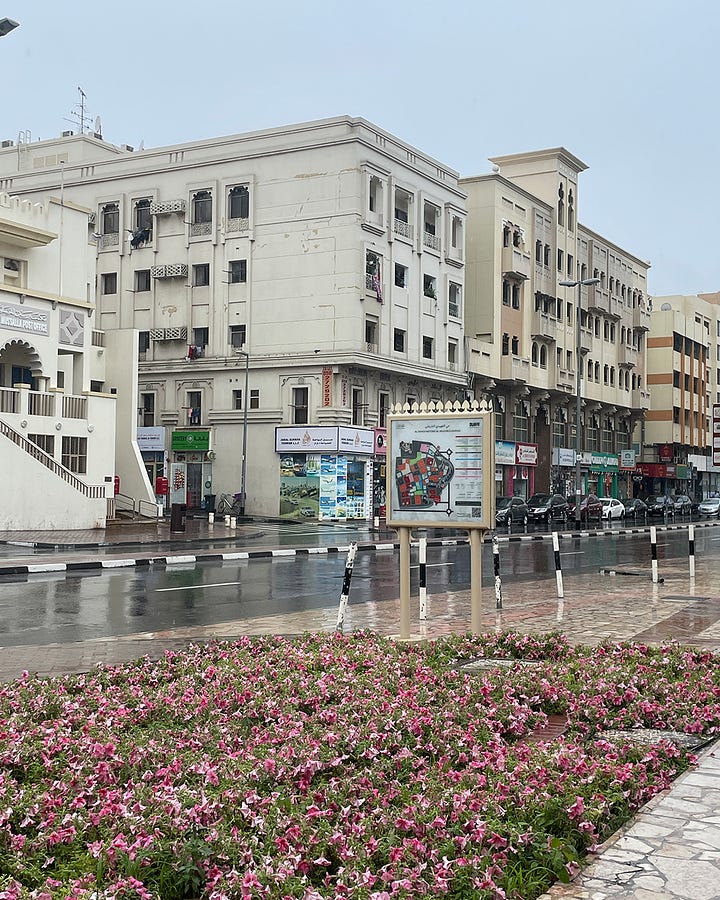

That morning, there was a very heavy rainstorm in Dubai when I arrived. I’m talking about grey skies, strong winds, and flooded toll roads kind of storm. “You’re lucky. This kind of storm only happens 5 days in a year” said my big brother who lives there. I mean, yeah, last time I remember, I don’t think I signed up for a rainstorm in the Emirates. But hey, talk about being in the 1% am I right?
With our half-dried clothes and a gloomy sky, the Egyptian Breakfast Platter definitely brings a smile to the table. It was majestic, to say the least, and could feed the entire family. I mean, for 78 AED, it better be.
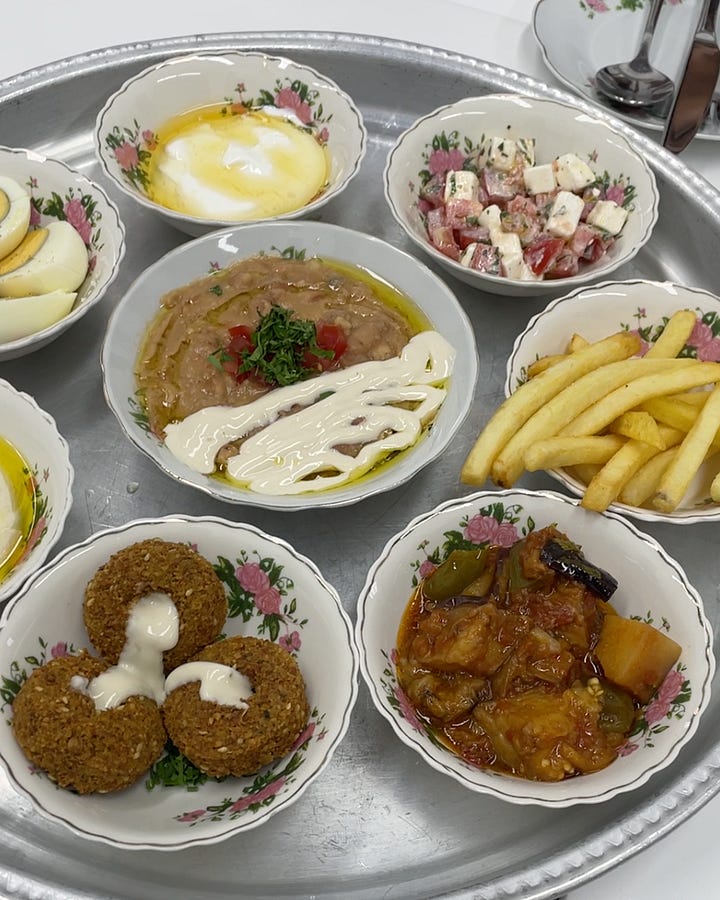

The tray consists of eight small plates, with a balanced mix of traditional and simpler dishes, like boiled eggs and fried potatoes that my little brother went for first. In the middle of the tray, are fork-tender foul beans, which I assumed were sauteed for a bit with spices like cumin, peppers, and garlic, and topped with a generous drizzle of olive oil, tahini, diced tomato, and parsley. Around them, there’s a simple tomato and white cheese salad, musaqaa (eggplant with tomato sauce), tahini and black molasses, hummus, and the beginning of my very high standard of falafel.
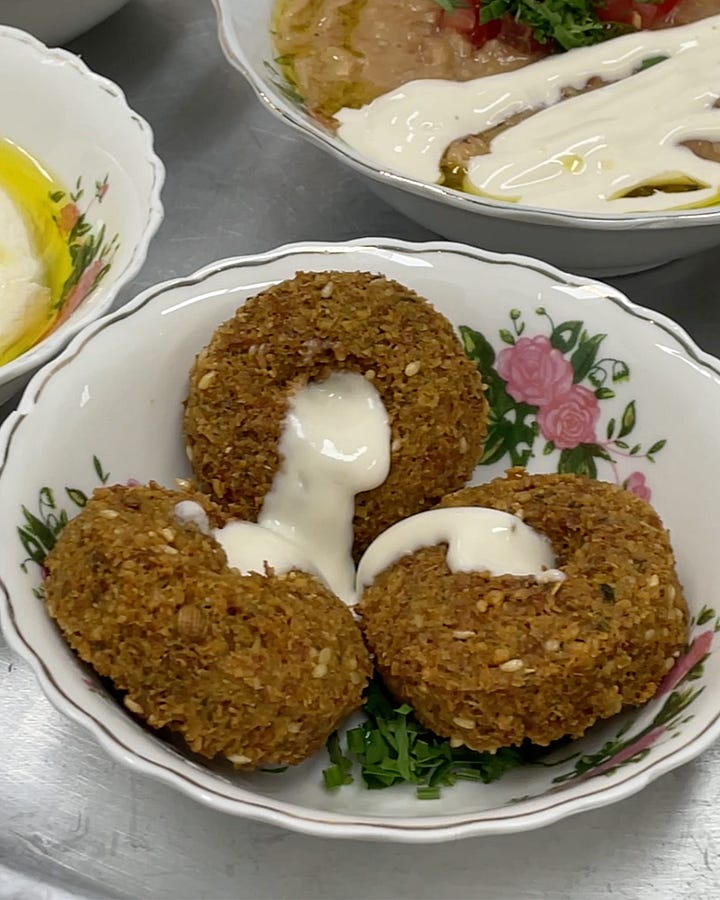

I had falafels before. So many times. But this right here, was otherworldly. They were super crispy on the outside, and they were thicc. Chonky even. This shape is what makes them juicy — or oily, as it absorbs the oil that fries them. But with a strong aroma typical of olive oil, I’d like to say they’re juicy instead.
It doesn’t even stop there because if you look at that white sauce on top of them, that’s pure tahini goodness. Also, don’t even get me started with the herbs. As if the parsley and cilantro inside the falafel are not enough, they put more of it chopped at the bottom of the plate. Having this falafel during my first day was a mistake because it set a very high standard of falafel for the rest of the trip, which, spoiler alert, remained the best one.
Why didn’t anyone tell me that all restaurants close during the day of Ramadan in Sharjah?
Located 30 kilometres northeast of Dubai, Sharjah is an emirate that I would say is like Dubai’s sober and more artsy sibling. It’s home to a few of the leading art museums in the country, including the Sharjah Museum of Islamic Civilization, Sharjah Heritage Museum, and Sharjah Art Foundation which hosted the last Sharjah Biennial, one of the most important contemporary art events in the Middle East.
At 8 AM, we took the ferry from Al Ghubaiba in Dubai to Sharjah and went to see a few of the exhibitions currently being shown in the museums. It was unreal to finally see the paintings and installations I had been eyeing for so long through my phone screen. Not to mention, half of the city is so picturesque. If Dubai was all grey and skyscrapers, Sharjah was beautifully tan. For a moment, I finally feel like I *am* in the Middle East.
Despite the 33 degrees sun directly above us, me and my family had a nice stroll around the city with our umbrella. At least until we arrived at the restaurants we planned to eat lunch at. Four of us were greeted with a big green sign in Arabic above us that said ‘Zam-zam Restaurant’, and some locked doors.
“Are we too early? But it’s past twelve already? Asked my dad. “Hmm, maybe it’s because of Ramadan? Maybe they changed their hours?” I assumed.
So we walked to the next restaurant that I saved on my Google Maps, stopping by a supermarket to buy some water when I noticed that every restaurant we passed by was also closed.
“No open. No restaurant open. Ramadan”, said one of the supermarket staff when I asked if there was any open restaurant nearby. “How about inside a mall?”, I insisted that there must be a place we can get food during the day. Which was quickly followed by a firm “No.”. At this point, I am still in my denial phase. So I just smiled nervously, saying OK multiple times and walked away.
Luckily, one of the other workers overheard our conversation and approached us, saying that he knew a spot. “Damn. Bro knew a spot.” I said to myself. He explained that just behind the block next to the supermarket, there’s a restaurant that usually sells food at this hour. “But only takeaway” he added.
We quickly went to the place the staff mentioned and found a big sign, now in red, that said “Uttam Restaurant”.
“It looks close to me,” my mom said. And I agree. Especially with the newspapers on the window blocking us from seeing what’s inside. But a quick look from the main door will let you see that they’re actually selling food inside. Imagine it’s a long and narrow restaurant, with the main door located near the right end. All the tables are either folded or filled with chairs stacked on top of them, except the two tables used for displaying the food for takeaways.



I scanned through the food on the table, and if I could see my own eyes, I swear that it was lit the moment I realised that they were selling Indian food. It’s almost like finding a jackpot in the form of paratha bread and samosa, and a double jackpot for the fact that it was all vegetarian. We bought some, took those away, and went to find a park to eat.
The paratha was interersting. It’s almost like it’s two paratha breads pressed together with fillings in between them. The fillings were curried potato and cauliflower, with a very straightforward note of asafoetida (hing), and a late kick of heat from what I guess was a bird’s eye chilli. Me personally, the chilli was too much if you were to eat it on its own. But that’s where the small cup of yoghurt saves the day as it neutralizes the heat once you dip the bread and eat them together. For the samosa, I couldn’t asked for a better one. It was chonky, crispy and flaky on the outside, and the steaming, soft, spicy potato fillings hit all the tastebuds.
Baba Ganoush, Baklava, and Red Falafels
Here are other foods that deserve a mention before going into part two.


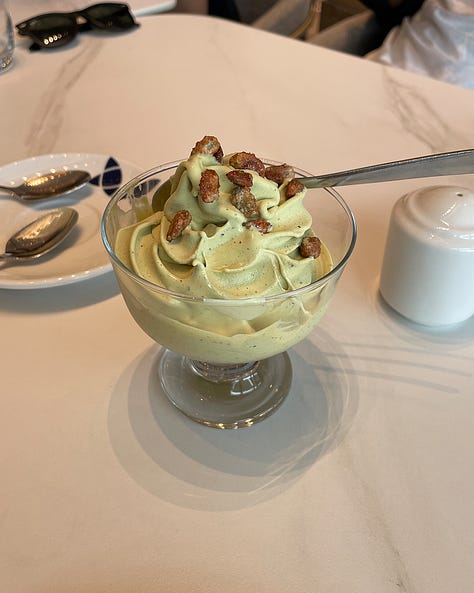
During our day trip to Abu Dhabi, we stopped at this Lebanese place called Al Safadi. Everyone else in my family got the chicken shawarma, and I’m pretty happy with my falafel version of it. But what I’m very stoked with is that I finally tried baba ganoush — a roasted eggplant dip, with aromatics like tahini and garlic. This version is even more extra with the added pomegranate seeds, and molasses that give an interesting sweet and sour tang. Also, their pistachio soft serve, with crispy candied pistachio, fucking slaps.
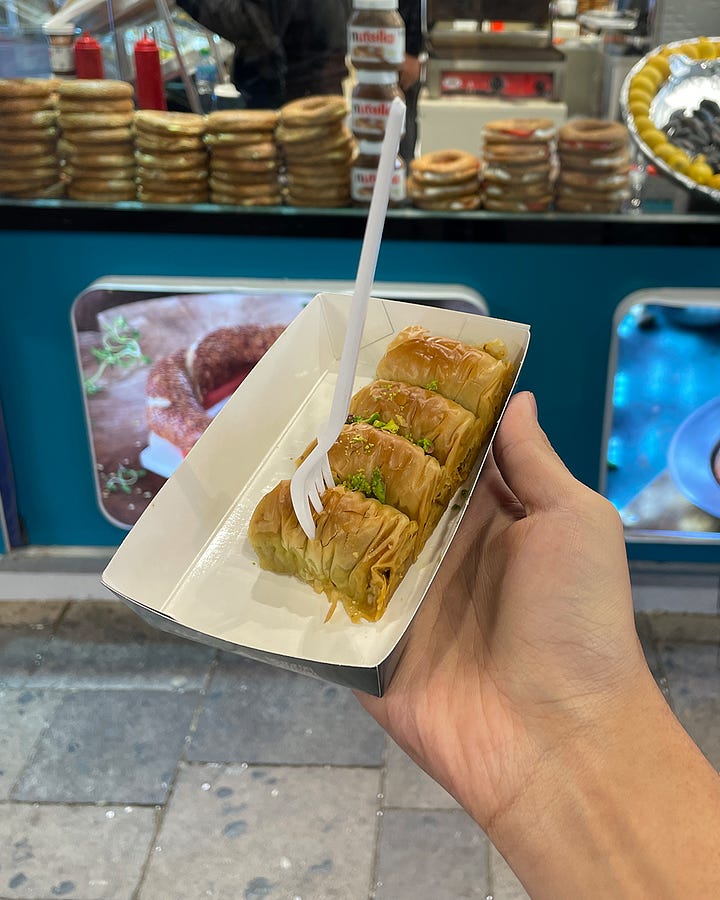
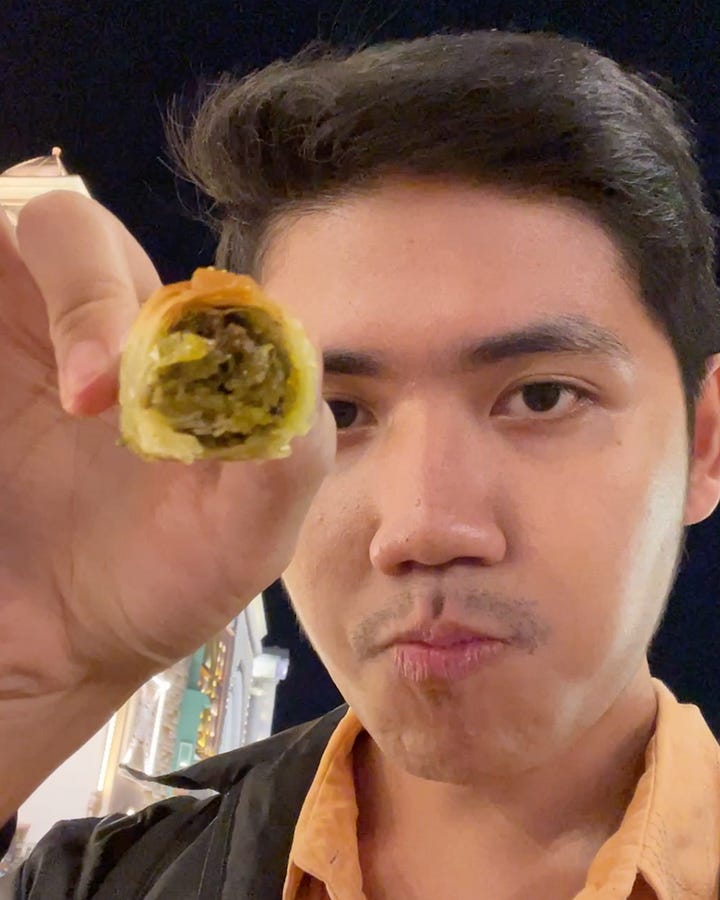
I don’t know what’s with the food here, but everything is chonky. Even the baklavas. These are the pistachio ones that I got from one of the stalls inside the Global Village area. They’re warm, flaky, and sticky. I specifically asked for a small portion of it because the normal one was literally a full tray and cost more than 50 AED. That’s almost as expensive as the Egyptian breakfast. This tiny portion cost me 35 AED. Not the most affordable, but perfect for a petite guy like me.

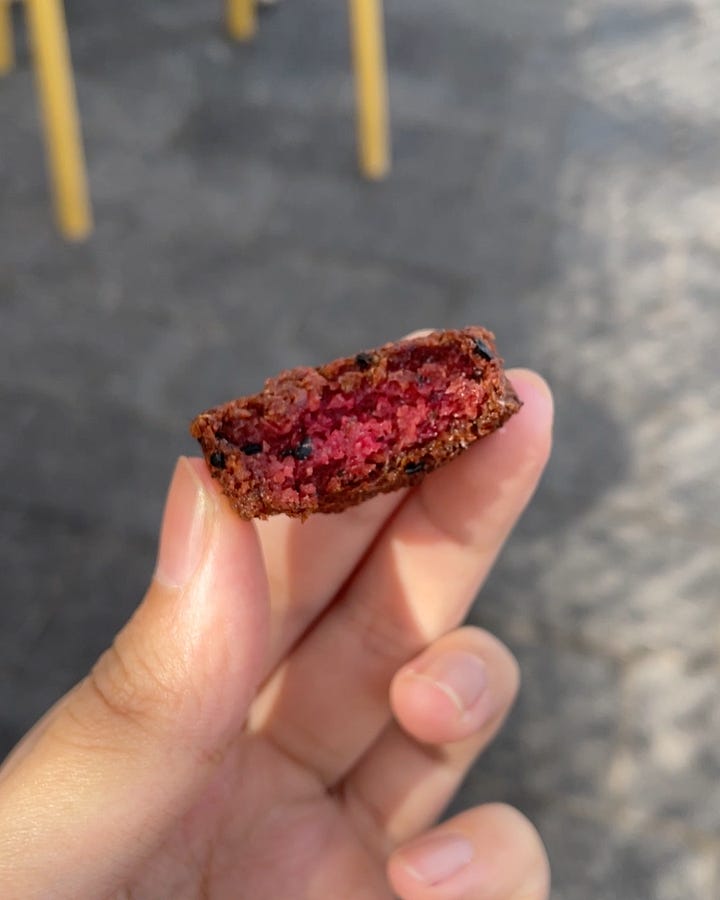
We went to a cafe around the Creekside area in Dubai, and I got their Vegetarian Platter which comes with a few pieces of pumpkin kibbeh, beetroot falafel, veggies, and yoghurt dip. When I ordered, it didn’t really sink into my head that the falafel would be red because of the beetroot. So I was pretty shocked and amazed when I first bit into it. Taste-wise, it was earthier than most falafels — the typical beetroot flavour. The overall texture was crispy, but it can be a lot juicier. Not gonna lie, it was very pretty, plus, it matched with my shirt that day.
That is it for part one! Which food are you most curious about? Let me know in the comments below, and subscribe to get the next part sent directly to your email! 😉
Other contents that I made recently:
📖 Read last week’s guest post by Mangan on Indonesian breakfast: here.
🍞 Read an essay on Indonesia’s wheat dependency problem: here.
🙅♀️ Read my essay on learning how to like the foods we hate: here.
🥕 A video recipe of Vegan Carrot & Paprika Soup: here.
If you like today’s newsletter, please like and share it with your friends! Comment down below your thoughts and let me know if you have any other topics you want me to discuss. Until then, I’ll see you in two weeks!
Follow me everywhere:
TikTok: @berusahavegan
Kepayang’s Instagram: @readkepayang
Instagram: @menggemaskan
LinkedIn: Chalafabia Haris
Work with me: readkepayang@gmail.com






Those prathas look good. Thanks for sharing, Chalafabia-
smiled the entire time reading